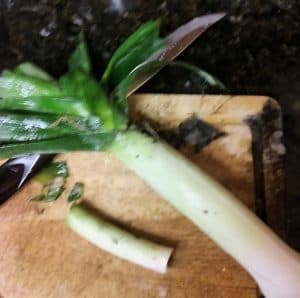I finally got some time this week to harvest the winter vegetables. The hard frosts we’ve experienced over the past several weeks killed some of the vegetation above ground, but the root vegetables were fine, and they tasted delicious.
Winter Vegetables – Harvest After a Frost
Winter vegetables taste better after a frost. Frost brings out the sugars in the plant cells and enhances the sweetness of the vegetables. For fall and winter vegetables such as broccoli and Brussel sprouts, it’s essential to leave them in the garden until after the first frost or else they taste bitter.
But what about other winter vegetables such as parsnips, carrots, beets, turnips, and leeks? I was so distracted with our new puppy this fall that I barely had time to clean up the garden let alone harvest all the delicious vegetables! (Yes, the puppy is a lot of fun, and he’s finally settling into the household routine, but it was a crazy fall all the same.) I left them alone and finally took a few minutes to pull them all.

Leeks – Delicious in the Fall
One of the vegetables I grew this year was leeks. Leeks are from the onion family. They are grown for the fleshy, white stem that, like an onion, is often used to flavor foods. The top green stems are cut off and composted. The bottom portion of the leek doesn’t form a bulb-like an onion but does flare out slightly.
Leeks have a more delicate, sophisticated taste than onions. I love adding them to vegetarian risotto and this weekend on our family menu is potato leek soup, another fall delicacy.
But leeks are quite expensive here in Virginia if you want to buy them at the supermarket and I find the taste rather bland. I purchased seeds from Baker Creek Heirloom Seeds this year for “Giant Musselburgh” leeks and I love them! This Scottish variety, introduced in 1834 in Edinburgh, Scotland, produces large, sweet, flavorful leeks. They grew easily and well in my garden. Highly recommended!
Parsnips, an Old-Fashioned Favorite
Another winter vegetable I love but that’s expensive and bland-tasting in the stores is parsnip. Parsnips are closely related to carrots and parsley. The large white roots are sliced and made into fries, baked, or mashed like potatoes (or even with potatoes). Serve them with butter and parsley and it’s heavenly!
I grew another Baker Creek variety, “Harris Model” and they also grew into vigorous, hardy plants. I harvested about half of them and filled a large bucket with parsnips; I store them in my cool garage near the kitchen door so I can grab them and cook with them quickly. They are sweet and tasty and peeled easily.
Turnips and Beets – Grow in the Fall Vegetable Garden
Two other winter vegetables that I enjoy are turnips and beets. Beets grow well for me in the spring but my fall and winter crops aren’t very good. The beets were small but I picked them anyway. I will boil them, peel them, and enjoy them in a salad this weekend.
For turnips, I buy inexpensive seeds for purple-top turnips. Again, I was distracted by my puppy and didn’t thin the turnip seeds. Oops. I had turnips growing on top of turnips but some attained the size of a billiard ball or larger so I pulled them and stored them in the garage, too. We like to boil them with potatoes and mash together for a zesty mashed potato dish; it tastes great with meatloaf.
Winter Vegetables to Grow
You can certainly purchase these and other winter vegetables at the grocery store, but as I found out, they can be very expensive. I think that’s because both parsnips and leeks take a very long growing season to mature; farmers need to sell crops quickly to remain solvent, so quick-turn crops like lettuce may make more sense for many farmers.
I planted both my leeks and parsnips in May and just let them be until November…and they were fine. A little weeding, a tad bit of compost, and lots of watering, and now I have delicious vegetables.




